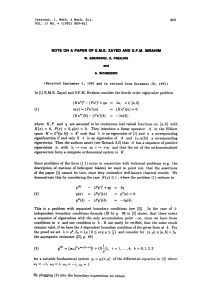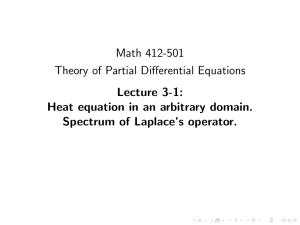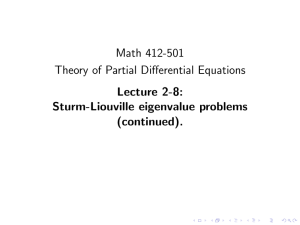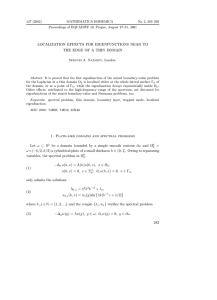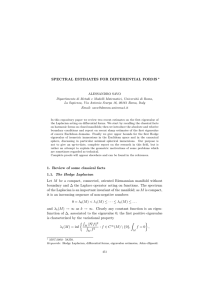Math 412-501 Theory of Partial Differential Equations Lecture 3-2:
advertisement
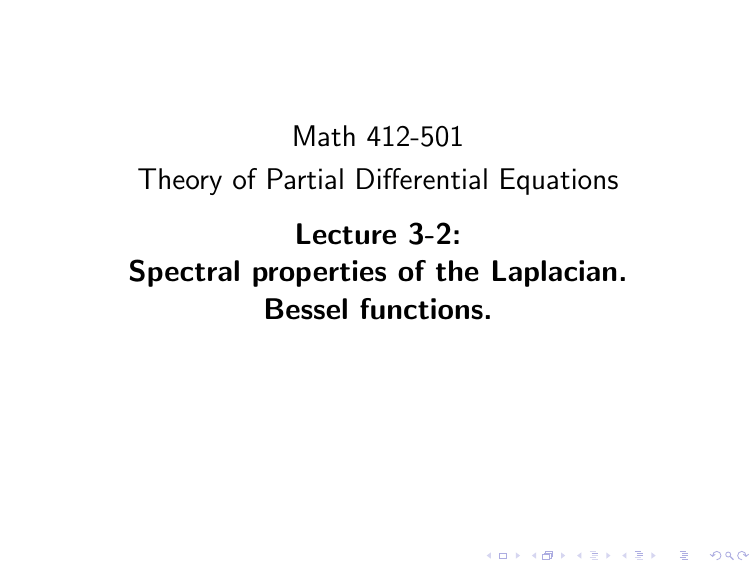
Math 412-501
Theory of Partial Differential Equations
Lecture 3-2:
Spectral properties of the Laplacian.
Bessel functions.
Eigenvalue problem:
∇2 φ + λφ = 0 in D,
∂φ αφ + β
= 0,
∂n ∂D
where α, β are piecewise continuous real functions
on ∂D such that |α| + |β| =
6 0 everywhere on ∂D.
We assume that the boundary ∂D is piecewise
smooth.
6 spectral properties of the Laplacian
Property 1. All eigenvalues are real.
Property 2. All eigenvalues can be arranged in
the ascending order
λ1 < λ2 < . . . < λn < λn+1 < . . .
so that λn → ∞ as n → ∞.
This means that:
• there are infinitely many eigenvalues;
• there is a smallest eigenvalue;
• on any finite interval, there are only finitely
many eigenvalues.
Property 3. An eigenvalue λn may be multiple
but its multiplicity is finite.
Moreover, the smallest eigenvalue λ1 is simple,
and the corresponding eigenfunction φ1 has no zeros
inside the domain D.
Property 4. Eigenfunctions corresponding to
different eigenvalues are orthogonal relative to the
inner product
ZZ
hf , g i =
f (x, y )g (x, y ) dx dy .
D
Property 5. Any eigenfunction φ can be related
to its eigenvalue λ through the Rayleigh quotient:
ZZ
I
∂φ
|∇φ|2 dx dy
φ
ds +
−
∂n
D
∂D
ZZ
.
λ=
2
|φ| dx dy
D
Property 6. There exists a sequence φ1 , φ2 , . . . of
pairwise orthogonal eigenfunctions that is complete
in the Hilbert space L2 (D).
Any square-integrable function f ∈ L2 (D) is
expanded into a series
X∞
cn φn (x, y ),
f (x, y ) =
n=1
that converges in the mean. The series is unique:
hf , φn i
.
cn =
hφn , φn i
If f is piecewise smooth then the series converges
pointwise to f at points of continuity.
Rayleigh quotient
Suppose that ∇2 φ = −λφ in the domain D.
Multiply both sides by φ and integrate over D:
ZZ
ZZ
|φ|2 dx dy .
φ ∇2 φ dx dy = −λ
D
D
Green’s formula:
I
ZZ
2
ψ ∇ φ dA =
D
∂φ
ds −
ψ
∂n
∂D
ZZ
D
∇ψ · ∇φ dA
This is an analog of integration by parts. Now
ZZ
I
ZZ
∂φ
2
|φ|2 dx dy .
φ
|∇φ| dx dy = −λ
ds −
∂n
D
∂D
D
It follows thatI
ZZ
∂φ
φ
−
|∇φ|2 dx dy
ds +
∂n
∂D
D
ZZ
.
λ=
2
|φ| dx dy
D
If φ satisfies the boundary condition φ|∂D = 0 or
∂φ ∂n ∂D = 0 (or mixed), then the one-dimensional
integral vanishes. In particular, λ ≥ 0.
If
∂φ
∂n
+ αφ = 0 on ∂D, then
I
I
∂φ
α|φ|2 ds.
ds =
φ
−
∂n
∂D
∂D
In particular, if α ≥ 0 everywhere on ∂D, then λ ≥ 0.
Self-adjointness
I
ZZ
2
ψ ∇ φ dx dy =
D
∂φ
ψ
ds −
∂n
∂D
ZZ
D
∇ψ · ∇φ dx dy
(Green’s first identity)
I ZZ
∂ψ
∂φ 2
2
(φ ∇ ψ − ψ ∇ φ) dx dy =
φ
−ψ
ds
∂n
∂n
∂D
D
(Green’s second identity)
If φ and ψ satisfy the same boundary condition
∂ψ ∂φ αφ + β
= αψ + β
=0
∂n ∂D
∂n ∂D
∂φ
then φ ∂ψ
∂n − ψ ∂n = 0 everywhere on ∂D.
If φ and ψ satisfy the same boundary condition then
ZZ
(φ ∇2 ψ − ψ ∇2 φ) dx dy = 0.
D
If φ and ψ are complex-valued functions then also
ZZ
(φ ∇2 ψ − ψ ∇2 φ) dx dy = 0
D
(because ∇2 ψ = ∇2 ψ and ψ satisfies the same
boundary condition as ψ).
Thus h∇2 φ, ψi = hφ, ∇2 ψi, where
ZZ
f (x, y )g (x, y ) dx dy .
hf , g i =
D
Eigenvalue problem:
∇2 φ + λφ = 0 in D,
∂φ αφ + β
= 0.
∂n ∂D
The Laplacian ∇2 is self-adjoint in the subspace of
functions satisfying the boundary condition.
Suppose φ is an eigenfunction belonging to an
eigenvalue λ. Let us show that λ ∈ R.
Since ∇2 φ = −λφ, we have that
h∇2 φ, φi = h−λφ, φi = −λhφ, φi,
hφ, ∇2 φi = hφ, −λφi = −λhφ, φi.
Now h∇2 φ, φi = hφ, ∇2 φi and hφ, φi > 0 imply λ ∈ R.
Suppose φ1 and φ2 are eigenfunctions belonging to
different eigenvalues λ1 and λ2 .
Let us show that hφ1 , φ2 i = 0.
Since ∇2 φ1 = −λ1 φ1 , ∇2 φ2 = −λ2 φ2 , we have that
h∇2 φ1 , φ2 i = h−λ1 φ1 , φ2 i = −λ1 hφ1 , φ2 i,
hφ1 , ∇2 φ2 i = hφ1 , −λ2 φ2 i = −λ2 hφ1 , φ2 i.
But h∇2 φ1 , φ2 i = hφ1 , ∇2 φ2 i, hence
−λ1 hφ1 , φ2 i = −λ2 hφ1 , φ2 i.
We already know that λ2 = λ2 . Also, λ1 6= λ2 .
It follows that hφ1 , φ2 i = 0.
The main purpose of the Rayleigh quotient
Consider a functional (function on functions)
ZZ
I
∂φ
|∇φ|2 dx dy
φ
ds +
−
∂n
D
∂D
ZZ
.
RQ[φ] =
2
|φ| dx dy
D
If φ is an eigenfunction of −∇2 in the domain D
with some boundary condition, then RQ[φ] is the
corresponding eigenvalue.
What if φ is not?
Let λ1 < λ2 ≤ λ3 ≤ . . . ≤ λn ≤ λn+1 ≤ . . . be
eigenvalues of a particular eigenvalue problem
counted with multiplicities.
That is, a simple eigenvalue appears once in this
sequence, an eigenvalue of multiplicity two appears
twice, and so on.
There is a complete orthogonal system φ1 , φ2 , . . . in
the Hilbert space L2 (D) such that φn is an
eigenfunction belonging to λn .
Theorem (i) λ1 = min RQ[φ], where the minimum
is taken over all nonzero functions φ which are
differentiable in D and satisfy the boundary
condition. Moreover, if RQ[φ] = λ1 then φ is an
eigenfunction.
(ii) λn = min RQ[φ], where the minimum is taken
over all nonzero functions φ which are differentiable
in D, satisfy the boundary condition, and such that
hφ, φk i = 0 for 1 ≤ k < n. Moreover, the minimum
is attained only on eigenfunctions.
h−∇2 φ, φi
Main idea of the proof: RQ[φ] =
.
hφ, φi
(see Haberman 5.6)
Spectral properties of the Laplacian in a circle
Eigenvalue problem:
∇2 φ + λφ = 0 in D = {(x, y ) : x 2 + y 2 ≤ R 2 },
u|∂D = 0.
In polar coordinates (r , θ):
1 ∂ 2φ
∂ 2 φ 1 ∂φ
+
+
+ λφ = 0
∂r 2
r ∂r
r 2 ∂θ2
(0 < r < R, −π < θ < π),
φ(R, θ) = 0
(−π < θ < π).
Additional boundary conditions:
|φ(0, θ)| < ∞ (−π < θ < π),
φ(r , −π) = φ(r , π),
∂φ
∂θ (r , −π)
=
∂φ
∂θ (r , π)
(0 < r < R).
Separation of variables: φ(r , θ) = f (r )h(θ).
Substitute this into the equation:
f ′′ (r )h(θ) + r −1 f ′ (r )h(θ) + r −2 f (r )h′′ (θ) + λf (r )h(θ) = 0.
Divide by f (r )h(θ) and multiply by r 2 :
r 2 f ′′ (r ) + r f ′ (r ) + λr 2 f (r ) h′′ (θ)
+
= 0.
f (r )
h(θ)
It follows that
r 2 f ′′ (r ) + r f ′ (r ) + λr 2 f (r )
h′′ (θ)
=−
= µ = const.
f (r )
h(θ)
The variables have been separated:
r 2 f ′′ + rf ′ + (λr 2 − µ)f = 0,
h′′ = −µh.
Boundary conditions φ(R, θ) = 0 and |φ(0, θ)| < ∞
hold if f (R) = 0 and |f (0)| < ∞.
Boundary conditions φ(r , −π) = φ(r , π) and
∂φ
∂φ
∂θ (r , −π) = ∂θ (r , π) hold if h(−π) = h(π) and
h′ (−π) = h′ (π).
Eigenvalue problem:
h′′ = −µh, h(−π) = h(π), h′ (−π) = h′ (π).
Eigenvalues: µm = m2 , m = 0, 1, 2, . . . .
µ0 = 0 is simple, the others are of multiplicity 2.
Eigenfunctions: h0 = 1, hm (θ) = cos mθ and
h̃m (θ) = sin mθ for m ≥ 1.
Dependence on r :
r 2 f ′′ + rf ′ + (λr 2 − µ)f = 0,
f (R) = 0, |f (0)| < ∞.
We may assume that µ = m2 , m = 0, 1, 2, . . . .
Also, we know that λ > 0 (Rayleigh quotient!).
√
New variable z = λ · r removes dependence on λ:
df
d 2f
+ (z 2 − m2 )f = 0.
z2 2 + z
dz
dz
This is Bessel’s differential equation of order m.
Solutions are called Bessel functions of order m.




